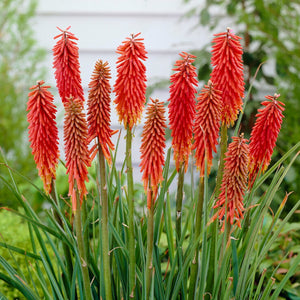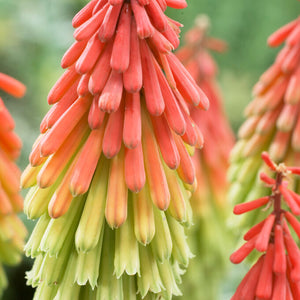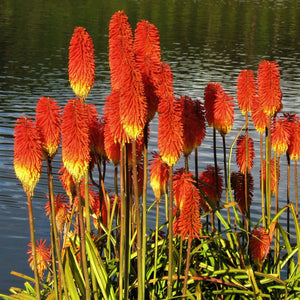Kniphofia Planting & Growing Guide
If you're looking to add something exotic to your landscape, then look no further than Kniphofia! Also known as Torch Lilies or Red-Hot Pokers, these plants form substantial, grassy clumps with towering flower spikes that are irresistible to hummingbirds and butterflies. Beyond being super easy to grow, these beauties can also manage drought, although they tend to bloom more profusely with supplemental water. So, would you care to learn more about these architectural wonders? Read on!
Success Snapshot
PLANTING
DEPTH
Crown at soil line

WATER
QUANTITY
Moderate to Low
SUNLIGHT
QUANTITY
Full to Partial Sun
PLANTING
PROXIMITY
24"
BLOOM
SEASON
Summer
HARDINESS
ZONES
Zones 6-9
Shop Related Products
Where to Plant
Plant your Kniphofia roots in an outdoor location with well-drained soil that receives full or partial sun. If you notice puddles of water 5–6 hours after a hard rain, scout out another site or amend the soil with organic material to raise the level 2–3 inches. While these plants aren't particularly fussy, they will not survive in soggy conditions or standing water.
When to Plant
Spring is the best time to plant Kniphofia roots in the garden, as they produce flowers for several weeks in the summer and go dormant in the winter. You can expect roots to begin to grow and top growth to become evident within just a few weeks of planting.
How to Plant
- Find a spot where the soil drains well and your plants will receive plenty of direct sunlight.
- Dig holes and plant the roots 18 to 42” apart, depending on the specific type, with the crown at the soil line.
- Water thoroughly after planting, soaking the soil to settle it around the roots.
How to Grow
- Provide supplemental water as needed in the spring and summer, with about 1" of moisture per week, although Kniphofia can tolerate less water once established.
- Cut down flower spikes but leave the foliage in place after blooming has finished for the season. The leaves will gather sunlight to create food through photosynthesis, strengthening the plant for the future.
- Remove the dry foliage when the leaves turn yellow and die back in the fall; some varieties are evergreen or semi-evergreen in warmer climates.
- Allow the plants to rest and the soil to dry out for a few months before beginning the next growing cycle in the spring.
Kniphofia Tips & Tricks
- Amend the soil with finely ground bark, decomposed manure, or compost to improve drainage and encourage a healthy start.
- Opt to plant your Kniphofia in the ground rather than containers, as the mature plants grow into large clumps that often measure 2 to 3' across.
- Expect the rhizomes you receive to have roots attached, making it easy to determine which end should face upwards.
- Enjoy the spectacular flowers, snipping a few for striking arrangements, as doing so will not hurt your plants and will actually encourage the production of more blossoms.
- Divide clumps of Kniphofia every 4 to 5 years. In cold-winter regions, divide the plants in spring. In warmer climates, divide them after they finish blooming.






